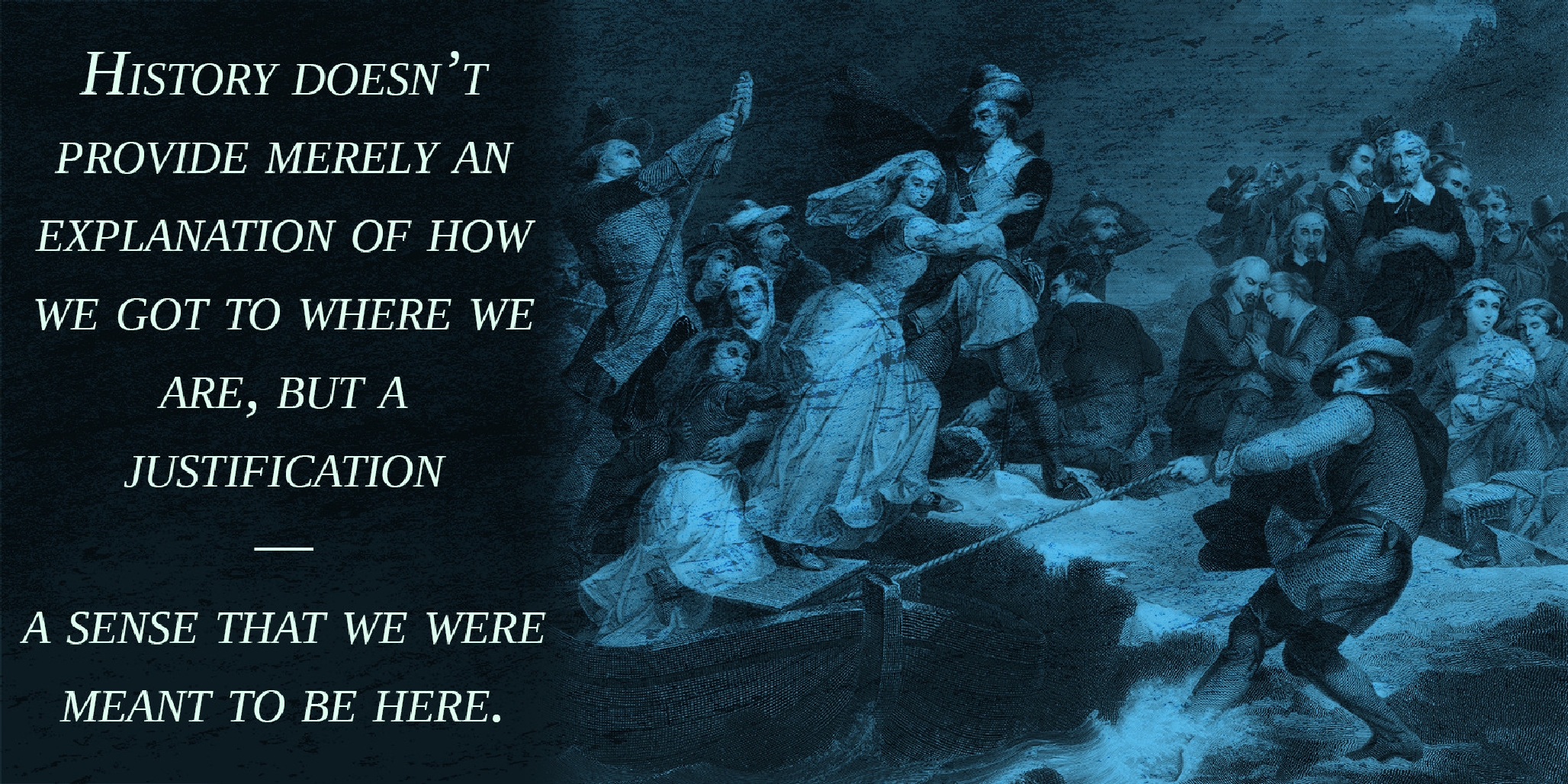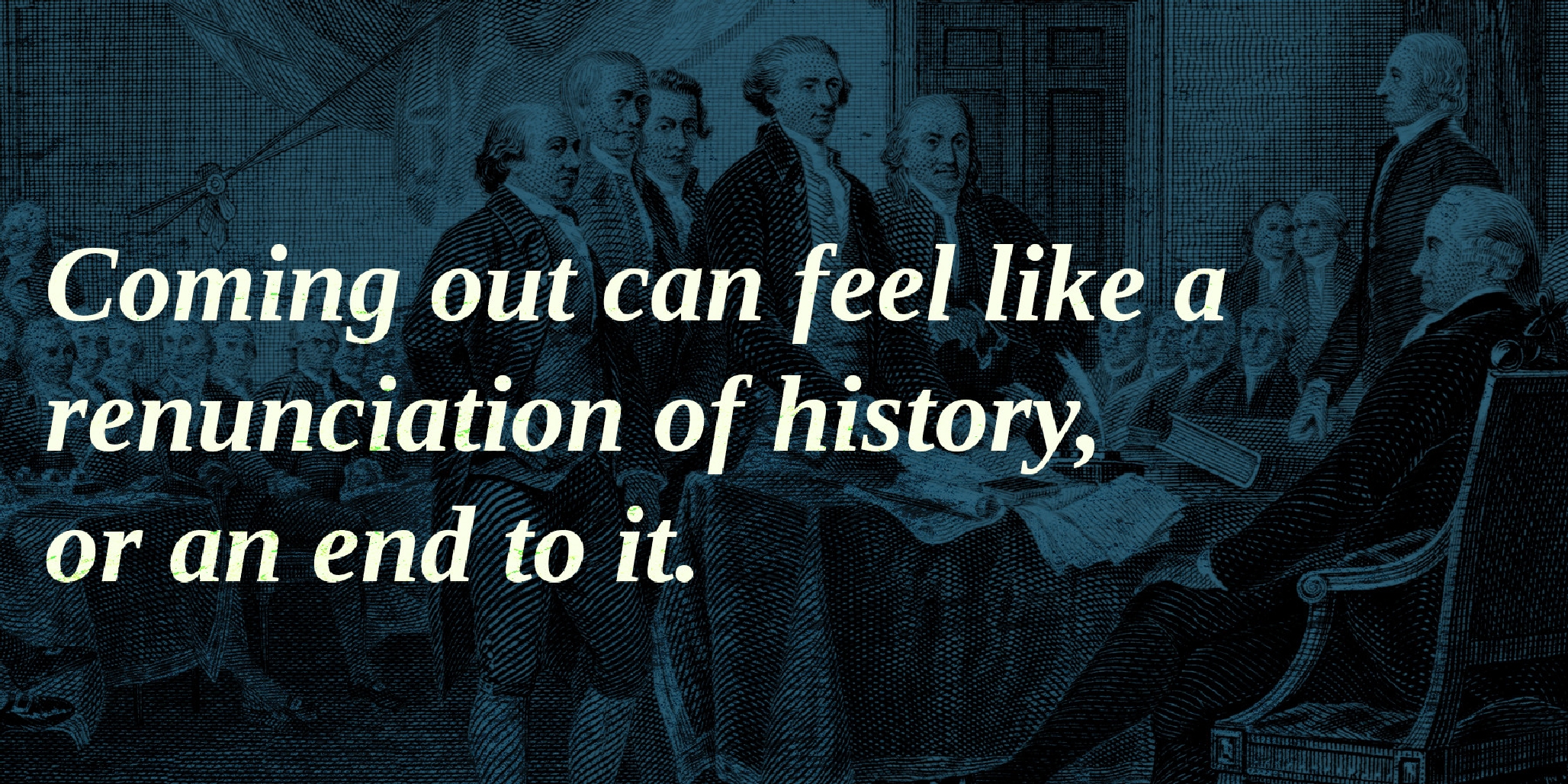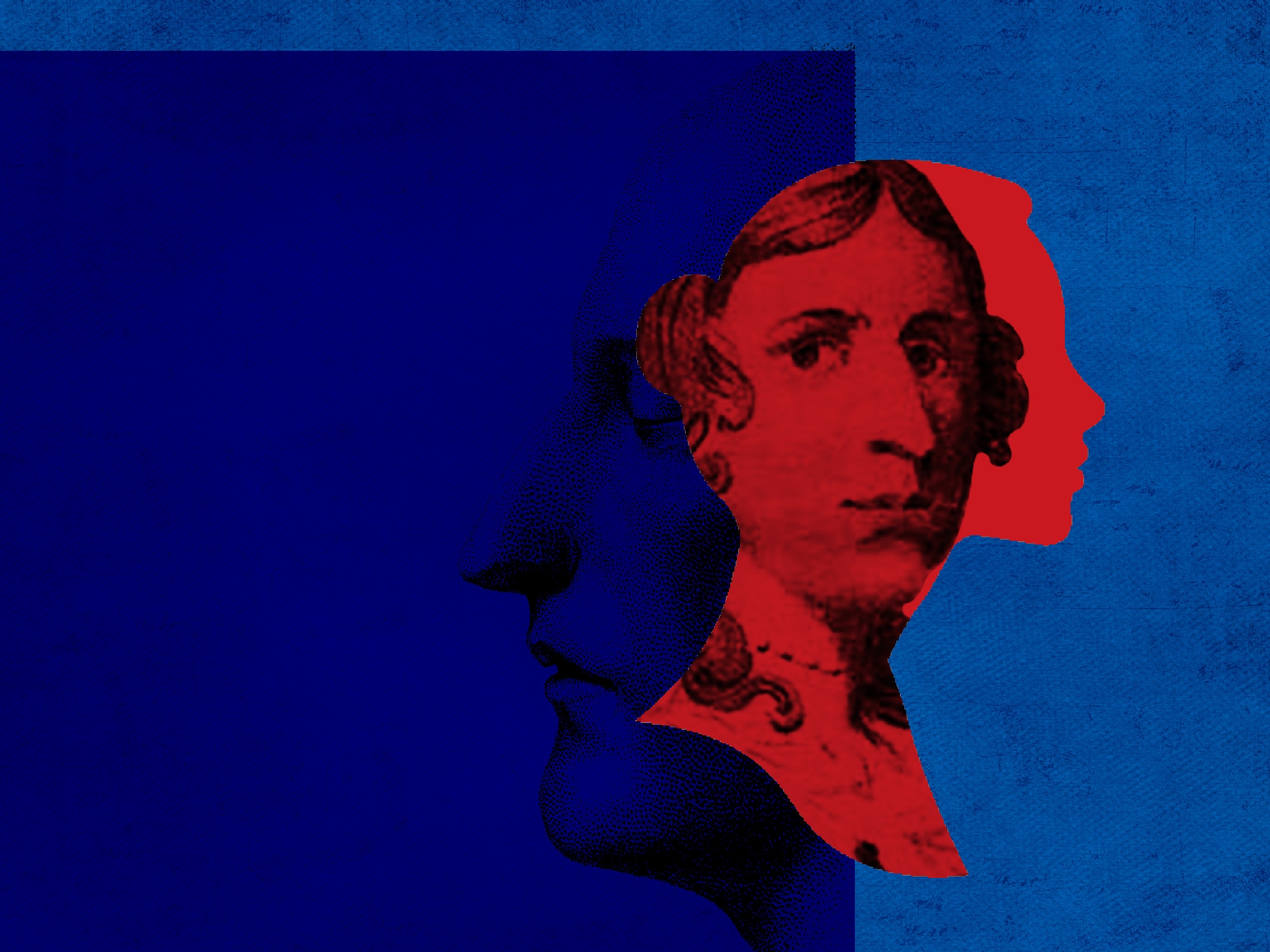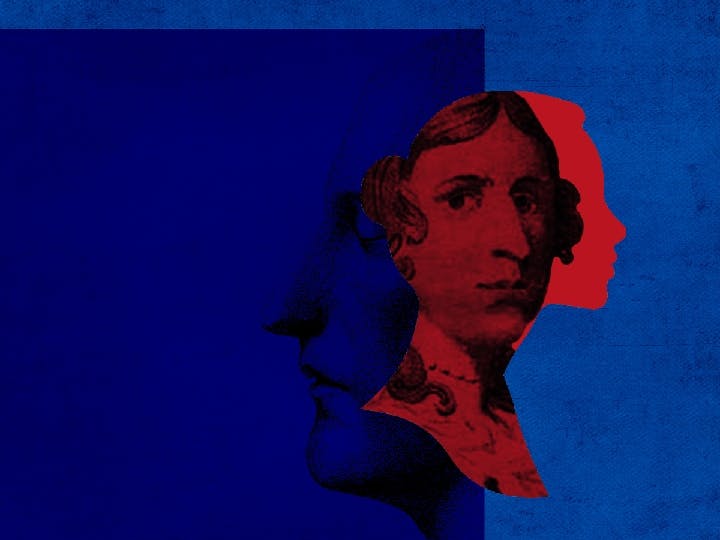Fall 2015
Out from behind the lines
– Alex Myers
There are the histories that are handed to us, into which we are expected to fit, and there are the histories that we must assemble for ourselves.
I asked my parents to sit down at the kitchen table. My mother instead leaned against the yellow Formica counter, her arms crossed over her chest. “I have something to tell you,” I began.
My mother shifted her weight. “I think I know what you’re going to say. You’re a lesbian, aren’t you?”
I shook my head and tried to look them in the eye: first my father, who had sat down in his chair across the table from me, then my mother, who still stood. “No,” I said. “I’m transgender.”
I let the word sit there for a moment. It was 1995. “Transgender” was a pretty new term; I’d just learned it myself not too long before. Neither of my parents said anything. “I’m going to live as a boy,” I told them.
Why was it so hard to get the words to come out? Why was it such a struggle to look them in the eye and tell them this truth?
A month or so earlier, when I had come out to myself at age 17 — when I had gone to a support group for LGBT youth and taken a seat next to a drag queen by the name of The Duchess Rose; when I had first said, I am transgender — it had been a relief, a moment of expansion, a wonderful embrace of self by self.
Now, as my mother began to cry and my father laid his hands on the table and said, “I think you should see a psychologist,” it was as if I could feel my family withdrawing from me, as if I had stepped not closer to them, but farther away, across a borderline: me on one side, them on the other.
It wasn’t only that I’d gone from being their daughter to asking to be their son. It was more than that. If family is like a river, with the seemingly ceaseless flow of parents to children to parents to children over the generations, then by announcing I was transgender, I’d separated myself from that current, entered some eddy.

So many identities in life are vertical, inherited from the previous generation: if you are black and the child of (a) black parent(s), Jewish and the child of (a) Jewish parent(s), and the like. In vertical relationships, where the offspring is like the parent, the history and heritage, the language and the culture, are passed along. Maybe not smoothly, maybe not intact, maybe not willingly or intentionally. But the passage happens.
Horizontal identities are not shared: if you are a lesbian and the child of straight parents, or transgender and the child of cisgender parents. What do they know, what can they teach you, about the lives of people like you? There might even be the sensation that those with horizontal identities have no history; that they pop up, sudden as mushrooms after a rainstorm, an abrupt eruption in an otherwise smooth family plot of ground.
And even once we know our horizontal nature, once we accept that there will be no easy reception of “our story” from the previous generation — no long evening spent over the photo album that reveals how we got to where we are — queer youth often feel reluctant to seek out their history. Perhaps it is because of the way in which straight history is taught. Not just the unending string of conquests, but also that increasingly tired and ridiculous saw: those who don’t understand history are doomed to repeat it, with the full implication being that everything that came before was a mistake. There is something about queerness that is a making-new — a second birth, the creation of a fresh, truer self. Perhaps that is why we have such difficulty locating our history.
In the den of the house where I grew up in Paris, Maine, floor-to-ceiling bookshelves stretched along one wall. At the very bottom, on the shelves most accessible when a child sat on the floor and wanted to pull out some volume, were Winnie the Pooh, The Wind in the Willows, and at least a dozen books on history. Most of them had to do with Jewish history — there was one particularly gruesome choose-your-own-adventure book set during the Spanish Inquisition, which always seemed to end with me on the rack — and the rest had to do with the Pilgrims. I’m not sure how deliberately the selections were curated, or if they were haphazardly acquired hand-me-downs.
There were two strands, two vertical lines that connected me to the past. One strand, represented in living form by my paternal grandmother — too cool, too eternally young to be called grandma, and so known as G. When, in her eighties, she became a great-grandmother, she went by G.G. She was never old. She was always fashionable. This line of my family stretched from the Pale of Settlement through a long sea voyage to the north shore of Massachusetts. It wove through two brothers, one a spiritual man — a Maggid, a not-quite-rabbi — who wandered the woods of Maine seeking out the little clusters of Jews who needed a bris or a wedding or merely a good d’var Torah. His name was Chaim, which was turned to Hyman when he arrived in the States. It is said that when he preached on gemelas chesed, he brought the women of the congregation to tears.
His brother was a businessman who began as a rag collector and gradually built a small empire of scrap paper and metal just north of Boston. There are the funny and hard-to-believe stories of G, his daughter, selling unbreakable combs during the Great Depression; of her growing up and going to the University of Alabama in the late 1930s, and being crowned the Jewish Homecoming Queen. There was, when she married, the good fortune that comes from owning a scrap-metal yard at the outbreak of a war, which allowed the family to move down to the Jewish mecca of Miami Beach in the 1950s, which is where my father grew up and where G lived until she died in 2014. All this history that reached right down to me as a seven-, eight-, nine-year-old girl, slightly carsick on the ride each Sunday morning to Hebrew School in Portland, Maine.
On my maternal side was my Grandmother Puffer, with her Boston accent so strong it could almost sound British. This vertical line was no single thread, but a whole tapestry. In Grandma Puffer’s living room was a chair, a dark wood frame with red velvet embroidered seat cushion. Over it, a sign: This chair came over on the Mayflower and was the property of Myles Standish. Up in the attic, there was a bugle played by some ancestor at William McKinley’s inauguration. There were samplers, their linen yellowed by age; their threads, once red and green, now muddled brown.
These I found haunting, the more-or-less even rows of stitched numbers and letters, and then at the bottom, a girl’s name: Lucy Sayre, Age 8. My mother taught me to cross-stitch, but we worked from patterns and bought brightly colored thread from Woolworth’s and in the end produced a neat little chickadee stitched into the bottom of a hand towel for the guest bathroom. Our efforts did not have the rote-ness of those long-ago girls’ samplers, the production of a piece that was so clearly a rehearsal for the rest of their lives, something to put in their “hope chests,” a phrase I found frightening (who keeps hope in a chest?). And yet there I was, stitching beside my mother, the two of us with our feet on the grate of the Franklin stove in the kitchen in Paris, Maine, passing idle winter hours. We were just one more pair of women in a line that stretched back hundreds of years.

Coming out can feel like a renunciation of all this history, or the end of that history (especially back in the days when it was harder for LGBT folks to procreate). Rarely, there can be a partial reclamation after coming out. I have a friend who, after he told his parents he was gay, listened as they analyzed the family tree — There was your uncle, Roger. Wasn’t he the hairdresser? Oh, and your cousin Jean, who liked horses. She never married. — trying to find other queer branches, trying to figure out how this strange fruit could have been produced.
When, in 1995, I sat at that kitchen table and told my parents that I am transgender, I wasn’t sure how I would fit. It wasn’t just how my parents would receive me — they loved me, they wanted me to be happy, and I knew this — it was how I would fit in some sense larger than myself. Where was my place in this family, in this world? When I first came out, I joined a support group with other transgender people, some of whom had been out for years, and I wanted to ask them how they did it. How do people like us live? In a sense, I was asking: who are we?
History doesn’t provide merely an explanation of how we got to where we are, but a justification as well, a sense that we were meant to be here. When I looked around at the other transgender people, when I looked at my family and then at myself, that sense of belonging, of having landed in a spot and knowing self and place well enough to call it home, was missing.
I am, however, fortunate. In the midst of all my Grandmother Puffer’s relics, I found a story for myself.
Every spring in my childhood, we would drive down from Maine to the outskirts of Boston where my grandmother lived, in order to watch the reenactments of the battles of Lexington and Concord. It meant getting up early. It meant my mother reciting a poem commemorating the day: On the eighteenth of April, in Seventy-five; / Hardly a man is now alive / Who remembers that famous day and year… and my brother and me interrupting to add our favorite adulterated line: when George Washington bit his ear! Then the crowds on the town green, and my father hoisting me on his shoulders so I could get a better look. The slow establishment of the British lines, like the accrual of sediment, neat rows of red-coated men. Far across the common was the quicker (though not quick enough for my youthful, impatient self) scrambling of the ill-accoutered militiamen. The roll of the drum, some barked commands, the pop and crackle as the British opened fire. A feeble reply from the minutemen. And then, the chaos of retreat and pursuit as the first billow of gunsmoke wafted over us spectators.
On the car ride back, my mother and grandmother would tell stories about our ancestors in the Revolutionary War. There was one who had been part of Benedict Arnold’s assault on Quebec; he had pushed the bateaux up Maine’s icy Kennebec River, only to be captured and imprisoned by the British. But the best story was the one about Deborah Samson.
As my grandmother used to tell it, Deborah was a servant in a small Massachusetts town. She was one of seven children and had watched her brothers march off to war. She was jealous; she wanted to go, too. So she ran away from home, disguised herself as a boy, and became a soldier. I think my mother and grandmother liked this story because of its uniqueness and fierceness — both of them had more than a little of Deborah’s determination and individuality. For them, Deborah was a wild woman, a rule-breaker, someone who would do things her way, everyone else’s opinions be damned.
I liked the story for a different resonance. I understood her jealousy all too well. I understood her desire exactly. I was, after all, a five- or six- or seven-year-old girl who understood that she was actually a boy, who wanted deeply to be treated as such, but who couldn’t, at that age, figure out the right words to express that feeling.
Somehow, Deborah Samson didn’t make it into the history books used in the Maine public school system in the 1980s. In an American history pageant we put on in third grade, the parts for women included Betsy Ross, Martha Washington, Molly Pitcher, and the nameless chorus of wives. I could usually count on being cast as Molly Pitcher, she being the most athletic and butch of the lot. (In fact, I can still sing the lines from one pageant: Molly Pitcher was a maid / She fought for freedom, unafraid / She carried water, fired a gun / and won the praise of Washington. Note how crucial that last line is: the fighting, carrying, and firing don’t mean a damn unless they get the patriarchal seal of approval.)
I can recall telling Deborah Samson’s story in school, maybe at show-and-tell or maybe as a query to my teacher: why aren’t we learning about this woman? Even well into high school, I still told Deborah’s story to friends. I think I was impressed by her, proud to have her in my family. I think I recognized some link between the two of us, well before I came out.
And then, much later, after coming out as transgender, after getting married, after testosterone, after graduate school, I wanted to write. I wrote short stories and essays at first, and then wanted to tackle a novel, to plunge into something big, something familiar and yet still unknown: Deborah’s story was perfect. What I discovered as I did my research for the novel was not just her story and not just the long shadows that touched my story, but a sense of the history of gender in this country — something that might be considered our history, a hint of what it means and has meant to be transgender, or at least not fitting normative gender roles in this nation.
On the meta-level, there is the story of her story. After she served in the army, Deborah Samson married, had children, fought for and was awarded a veteran’s pension, and then undertook a speaking tour. She would get onstage wearing her normal female garb, give a speech about her life and her service in the army, then go backstage, change into her uniform, and reappear with a musket to go through the manual exercise of arms, the military drill. If that’s not drag, I don’t know what is.

This lecture tour wasn’t part of the tale that my grandmother told me: perhaps my grandmother didn’t find it as intriguing as Deborah’s service in the army. But more likely, she didn’t know the story. Until recently, the records of Deborah’s speaking tour were rather hard to scratch up. The reason is simple: while in the late 1790s and early 1800s there was a strong movement for women’s rights in both America and Britain (Mary Wollstonecraft and others were active in this period), within the next decade that interest would not just fade, but provoke a backlash against it.
By the 1820s, a more conservative view of woman’s proper sphere was being articulated and, as the history of the American Revolution was being codified in books and scholarly writing, Deborah Samson’s story was left out. Other women played small roles. They behaved as women should; Betsy Ross, for example, is famed for sewing. Their roles were supporting in the literal sense — Abigail Adams and Molly Pitcher were in service both to husband and country. Deborah Samson, by contrast, was dangerous. She was a woman who had broken free. She was a woman who had proven her ability to be equal to men.
When I wrote my debut novel, Revolutionary, I came to know a story much more complex than what my grandmother had presented. Deborah wasn’t just jealous; she wasn’t motivated by patriotism. Her life choices were either to be enslaved or to be a pariah. She had opted to be a pariah. When she was freed from indenture at age 18, she decided not to marry and not to enter into service for another household. Instead, she became a so-called “masterless woman” and supported herself through weaving, teaching, and doing farm work. She scarcely scraped a living in this piecemeal fashion, and when the military recruiters came through in 1782 their offer of a 20-pound bounty for enlistment must have been irresistible. The dilemma Deborah faced was stark: to survive as a woman at the time, she would have had to find a man to be her master, either as his wife or as his servant, or she would have to be a man herself.
That was my first realization of just how different the terms of gender roles were at the time. The second had to do with transgender identity: I wanted to figure out how similar Deborah and I were. Did she, like me, always want to be or think of herself as a boy? This question would, of course, prove impossible to answer definitively, absent a confessional narrative or diary from Deborah herself.
Instead, I tried to get at the question by looking at vocabulary and story, the language used for and around women at the time. The words “tomboy,” “Amazon,” and “virago” were all in use then. Abigail Adams used “Amazon” as a positive term, to show how willing women would be to fight for their country, but otherwise these terms were strongly negative. Deborah would have known that she had precedents in the stories of Joan of Arc and of Hannah Snell, the latter of whom had served in the British Navy while disguised as a man early in the eighteenth century. The idea of women disguising themselves as men would have been quite familiar to Deborah. It was a staple of literature and the stage, with the cross-dressing often occurring in service of helping a woman to elope with the man of her choice.
Outside of the romantic context, female crossdressing in literature and real life at the time was deployed to achieve a short-term goal: to get out of an abusive marriage or obtain some money or gain justice. At the time, it was impossible for women to do certain things, so one had to be a man in order to do them. This was generally understood, if not generally accepted. It was logical, in some way, for a woman to want to, need to, be a man. That was practical. But what I realized as I read the literature of the time was that for a woman to put on men’s clothes and go forth to achieve her (masculine) purpose — this action was not a statement of her gender identity at all. The clothes were a disguise. Any adventure that she had was a (possibly grand) masquerade. It was a period of exception to her normal life and her normal self. There was no precedent for someone like Deborah, a woman who took on men’s clothes and never took them off again — no precedent except Joan of Arc, and she was killed for it.
I don’t doubt that there were women who lived as men for much of their lives, even in Deborah’s time. And I don’t think that it is language, per se, that allows us to be, but I do think there is a correlation between naming and seeing. Words render visible. Words reify. As I wrote Deborah’s story, I realized how hard it would have been for her to imagine a future for herself.
In the years since I came out as transgender, I have read up on our history as much as I can, chasing down stories of historical figures who crossdressed, looking at newspaper coverage of famous cases. In America, once the West opened up, it was easier for women to live their lives as men, to go far enough away that no one would know who they had been before. There were more people who were similarly alone in the world because of the massive influx of immigrants. You could, as a transgender person, be yourself — you just had to leave your family to do so.
I am part of the first generation of transgender people for whom being transgender does not always require running away from history.
When I came out to my grandmothers, I wasn’t entirely sure what to expect. My Grandmother Puffer absorbed the news in her typical taciturn way. A year later, I was effectively disowned and never saw her again. When I came out to G, she said, “Oh, that’s wonderful. I can’t wait to tell my mahjong group. Transgender is very ‘in’ down here in Miami Beach.” In college and later, when I went to visit G, she’d often take me to her favorite restaurant, which turned into a gay bar after hours. She’d been a customer for years and knew the owner well. Whenever we sat down, he’d come over and G would introduce me: My grandson. He’s transgender. It made me feel like a fashion accessory. I loved it.
My parents stumbled over pronouns for a few years, but were patient and persistent as they gained understanding of what it meant for me to be transgender, to be their son. I graduated from college, I got married, I started a career as a teacher — I did these things, and I was out as transgender as I did them. I attended the bar mitzvahs and weddings and birthdays of my cousins and nieces and aunts; I was there, and I was out — I was both myself and one of them.
I believe that I am part of the first generation of transgender people for whom being transgender does not always require running away. This is the first step to knowing, acknowledging, and valuing our history: staying where we are and who we are. Being part of our families.
It’s funny, what makes me believe I have a place in the world. There are the books like the ones that used to sit on the shelves of my childhood home, children’s books on Jewish history, dinosaurs, story after story that explained how we (humans, Jews, Pilgrims) got to where we are — stories that are logical, privileging, designed to give a sense of rightness, of just deserts, of ownership and belonging. And then there are the stories that no book contains, the stories that are told around the dinner table, or spoken during long car rides when it is easy to gaze ahead through the windshield and not have to meet the other person’s eyes.
There are the histories that are handed to us, into which we are expected to fit, and there are the histories that we must assemble for ourselves, around ourselves, the lines we have to draw to connect us to a past, so that we can turn around and say, “You see? I was meant to be here.”
* * *
Alex Myers is a writer, teacher, speaker, and activist. Since high school, Alex has campaigned for transgender rights. He was the first openly transgender person at Phillips Exeter Academy and Harvard and worked to change the latter's nondiscrimination clause to include gender identity.
